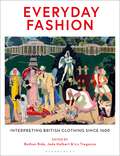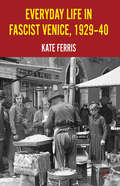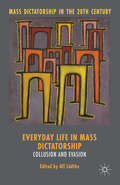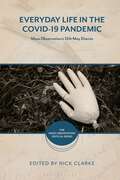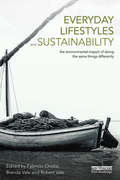- Table View
- List View
Everyday Fashion: Interpreting British Clothing Since 1600
Ordinary clothes have extraordinary stories. In contrast to academic and curatorial focus on the spectacular and the luxurious, Everyday Fashion makes the case that your grandmother's wardrobe is an archive as interesting and important as any museum store. From the moment we wake and get dressed in the morning until we get undressed again in the evening, fashion is a central medium through which we experience the world and negotiate our place within it. Because of this, the ways that supposedly 'ordinary' and 'everyday' fashion objects have been designed, manufactured, worn, cared for, and remembered matters deeply to our historical understanding.Beginning at 1550 – the start of an era during which the word 'fashion' came to mean stylistic change rather than the act of making – each chapter explores the definition of everyday fashion and how this has changed over time, demonstrating innovative methodologies for researching the everyday. The variety and significance of everyday fashion cultures are further highlighted by a series of illustrated object biographies written by Britain's leading fashion curators, showcasing the rich diversity of everyday fashion in British museum collections. Collectively, this volume scratches below the glossy surface of fashion to expose the mechanics of fashion business, the hidden world of the workroom and the diversity and role of makers; and the experiences of consuming, wearing, and caring for ordinary clothes in the United Kingdom from the 16th century to the present day. In doing so it challenges readers to rethink how fashion systems evolve and to reassess the boundaries between fashion and dress scholarship.
Everyday Fashion in Found Photographs: American Women of the Late 19th Century
by Lisa HodgkinsIn the last half of the 19th century, the women of America were beginning to develop their own sense of style. Although influenced by European fashions and the social and economic changes of the time, they made clothing choices based upon their personal aspirations and their practical everyday needs. Providing an overview of fashion influences for each decade from the 1860s to the end of the century, Everyday Fashion in Found Photographs presents iconic garments, using sources from the period, to provide commentary and detailed description of the styles of the time. Previously unpublished vintage photographs show women across the social spectrum wearing items such as the Garibaldi shirt, the cuirass bodice, the Mother Hubbard, bicycle bloomers, and much more. Names, dates and functions of garments are examined in detail, and ties are established between social and historical contexts and the evolution of clothing styles.This illustrated book is for readers who want to identify and understand specific clothing items as well as gain insight into the mind-set of fashionable women from Victorian-era America. Dress history scholars, costume designers, curators of costume collections, social and cultural historians and those who appreciate vintage photographs can learn about elements of late 19th century women's dress and thereby develop an understanding of what was fashionable, and why.
Everyday Fashion in Found Photographs: American Women of the Late 19th Century
by Lisa HodgkinsIn the last half of the 19th century, the women of America were beginning to develop their own sense of style. Although influenced by European fashions and the social and economic changes of the time, they made clothing choices based upon their personal aspirations and their practical everyday needs. Providing an overview of fashion influences for each decade from the 1860s to the end of the century, Everyday Fashion in Found Photographs presents iconic garments, using sources from the period, to provide commentary and detailed description of the styles of the time. Previously unpublished vintage photographs show women across the social spectrum wearing items such as the Garibaldi shirt, the cuirass bodice, the Mother Hubbard, bicycle bloomers, and much more. Names, dates and functions of garments are examined in detail, and ties are established between social and historical contexts and the evolution of clothing styles.This illustrated book is for readers who want to identify and understand specific clothing items as well as gain insight into the mind-set of fashionable women from Victorian-era America. Dress history scholars, costume designers, curators of costume collections, social and cultural historians and those who appreciate vintage photographs can learn about elements of late 19th century women's dress and thereby develop an understanding of what was fashionable, and why.
Everyday Forms of Peasant Resistance
by Forrest D. ColburnPeasant rebellions are uncommon. "Everyday Forms of Peasant Resistance" explores peasants' foot dragging, feigned ingorance, false compliance, manipulation, flight, slander, theft, arson, sabotage, and similar prosaic forms of struggle. These kinds of resistance stop well short of collective defiance, a strategy usually suicidal for the subordinate. The central argument about peasant resistance is presented in the opening chapter by James Scott in which he summarizes and extends the thesis of his book on Malaysia's peasantry, "Weapons of the Weak". Scott's ideas are employed and refined in the ensuing seven country studies of peasant resistance: Poland, India, Egypt, Colombia, China, Nicaragua and Zimbabwe.
Everyday Forms of Peasant Resistance
by Forrest D. ColburnPeasant rebellions are uncommon. "Everyday Forms of Peasant Resistance" explores peasants' foot dragging, feigned ingorance, false compliance, manipulation, flight, slander, theft, arson, sabotage, and similar prosaic forms of struggle. These kinds of resistance stop well short of collective defiance, a strategy usually suicidal for the subordinate. The central argument about peasant resistance is presented in the opening chapter by James Scott in which he summarizes and extends the thesis of his book on Malaysia's peasantry, "Weapons of the Weak". Scott's ideas are employed and refined in the ensuing seven country studies of peasant resistance: Poland, India, Egypt, Colombia, China, Nicaragua and Zimbabwe.
Everyday Hate: How antisemitism is built into our world – and how you can change it
by Dave Rich“Compelling, frightening and illuminating.” – Daniel Finkelstein“Everyone should read this book.” – Sacha Baron Cohen“An important and detailed tour through the history of antisemitism – and an even more important look at the present.” – Marina Hyde“Dave Rich is a lodestar for understanding, and therefore challenging, antisemitism.” – David Baddiel***Antisemitism is supposed to have disappeared long ago, but despite our abhorrence of racism and oppression in all its forms, this ancient prejudice continues to thrive. Anti-Jewish hate crime is rising, Jewish blood is spilt in Europe once more and arguments over antisemitism, whether in politics or music, theatre or sport, are increasingly hard to avoid. At a time of economic, political and social turmoil, fuelled by conspiracy theories on your smartphone or conflict in the Middle East, antisemitism is back, and we need to know why.It would be tempting to put this down to a handful of extremists, but antisemitism endures at an everyday level in the stereotypes and assumptions about Jews that are woven into the fabric of our world. It is these almost-unnoticed prejudices that perpetuate violent hatred, and until we all understand where they came from, how they are sustained and how they can be challenged, they will continue to do so.Blending personal anecdotes, contemporary examples and historical insights, Everyday Hate takes you on a journey through this contentious and often confusing subject. Spanning Shakespeare to South Park, Israel to Covid-19 and ancient stereotypes to internet memes, it reveals surprising truths about how antisemitism continues to thrive in the interactions, assumptions and views of decent people around the world – and how we can change this for the better.
Everyday Heroism: Victorian Constructions Of The Heroic Civilian
by John PriceHeroism in the 19th and early 20th centuries is synonymous with military endeavours, imperial adventures and the 'great men of history'. There was, however, another prominent and influential strand of the idea which has, until now, been largely overlooked. This book seeks to address this oversight and establish new avenues of study by revealing and examining 'everyday' heroism; acts of life-risking bravery, undertaken by otherwise ordinary individuals, largely in the course of their daily lives and within quotidian surroundings.Adopting an interdisciplinary approach, John Price charts and investigates the growth and development of this important discourse, presenting in-depth case studies of The Albert Medal and the Carnegie Hero Fund alongside a nationwide analysis of heroism monuments and an exploration of radical approaches to the concept. Unlike its military and imperial counterparts, everyday heroism embraced the heroine and this study reflects that with an examination of female heroism.Discovering why certain individuals or acts were accorded the status of being 'heroic' also provides insights into those that recognized them. Heroism is a flexible and malleable constellation of ideas, shaped or constructed along different lines by different people, so if you want to identify the characteristics of a group or society, much can be learnt by studying those it holds up as heroic. Consequently, Everyday Heroism: Victorian Constructions of the Heroic Civilian provides valuable and revealing evidence for a wide range of social and cultural topics including; class, gender, identity, memory, celebrity, and literary and visual culture.
Everyday Heroism: Victorian Constructions Of The Heroic Civilian
by John PriceHeroism in the 19th and early 20th centuries is synonymous with military endeavours, imperial adventures and the 'great men of history'. There was, however, another prominent and influential strand of the idea which has, until now, been largely overlooked. This book seeks to address this oversight and establish new avenues of study by revealing and examining 'everyday' heroism; acts of life-risking bravery, undertaken by otherwise ordinary individuals, largely in the course of their daily lives and within quotidian surroundings.Adopting an interdisciplinary approach, John Price charts and investigates the growth and development of this important discourse, presenting in-depth case studies of The Albert Medal and the Carnegie Hero Fund alongside a nationwide analysis of heroism monuments and an exploration of radical approaches to the concept. Unlike its military and imperial counterparts, everyday heroism embraced the heroine and this study reflects that with an examination of female heroism.Discovering why certain individuals or acts were accorded the status of being 'heroic' also provides insights into those that recognized them. Heroism is a flexible and malleable constellation of ideas, shaped or constructed along different lines by different people, so if you want to identify the characteristics of a group or society, much can be learnt by studying those it holds up as heroic. Consequently, Everyday Heroism: Victorian Constructions of the Heroic Civilian provides valuable and revealing evidence for a wide range of social and cultural topics including; class, gender, identity, memory, celebrity, and literary and visual culture.
Everyday humanitarianism in Cambodia: Challenging scales and making relations (Humanitarianism: Key Debates and New Approaches)
by Anne-Meike FechterFaced with the scale of global challenges such as poverty and inequality, one question is where to start. Humanitarian efforts can only ever have limited reach. Among all of human suffering, whom should we support? And what shapes our choices? Such questions are at the core of this book. Through an ethnographic account of moralities, it traces how everyday humanitarian practitioners challenge entrenched values of what matters, upending the notion that the large-scale is inherently important, and even questioning what ‘large’ means in the first place. Instead, these practitioners typically aim to create a difference in the life of a particular person, situating their limited actions within pervasive poverty.
Everyday humanitarianism in Cambodia: Challenging scales and making relations (Humanitarianism: Key Debates and New Approaches)
by Anne-Meike FechterFaced with the scale of global challenges such as poverty and inequality, one question is where to start. Humanitarian efforts can only ever have limited reach. Among all of human suffering, whom should we support? And what shapes our choices? Such questions are at the core of this book. Through an ethnographic account of moralities, it traces how everyday humanitarian practitioners challenge entrenched values of what matters, upending the notion that the large-scale is inherently important, and even questioning what ‘large’ means in the first place. Instead, these practitioners typically aim to create a difference in the life of a particular person, situating their limited actions within pervasive poverty.
The Everyday in Visual Culture: Slices of Lives
by François Penz Janina SchuppThis book explores how the comparative analysis of visual cultural artefacts, from objects to architecture and fiction films, can contribute to our understanding of everyday life in homes and cities around the globe. Investigating the multiple facets of the everyday, this interdisciplinary collection generates a new awareness of everyday lives across cultures and challenges our traditional understanding of the everyday by interweaving new thematic connections. It brings together debates around the analysis of the everyday in visual culture more broadly and explores the creation of innovative technological methods for comparative approaches to the study of the everyday, such as film databases, as well as the celebration of the everyday in museums. The volume is organized around four key themes. It explores the slices of everyday lives found in Visual Culture (Part I), Museums (Part II), the City (Part III) and the Home (Part IV). The book explores the growing area of the analysis of everyday life through visual culture both broadly and in depth. By building interdisciplinary connections, this book is ideal for the emerging community of scholars and students stemming from Visual Culture, Film and Media Studies, Architecture Studies and practice, Museum Studies, and scholars of Sociology and Anthropology as well as offering fresh insights into cutting-edge tools and practices for the rapidly growing field of Digital Humanities.
The Everyday in Visual Culture: Slices of Lives
by François Penz Janina SchuppThis book explores how the comparative analysis of visual cultural artefacts, from objects to architecture and fiction films, can contribute to our understanding of everyday life in homes and cities around the globe. Investigating the multiple facets of the everyday, this interdisciplinary collection generates a new awareness of everyday lives across cultures and challenges our traditional understanding of the everyday by interweaving new thematic connections. It brings together debates around the analysis of the everyday in visual culture more broadly and explores the creation of innovative technological methods for comparative approaches to the study of the everyday, such as film databases, as well as the celebration of the everyday in museums. The volume is organized around four key themes. It explores the slices of everyday lives found in Visual Culture (Part I), Museums (Part II), the City (Part III) and the Home (Part IV). The book explores the growing area of the analysis of everyday life through visual culture both broadly and in depth. By building interdisciplinary connections, this book is ideal for the emerging community of scholars and students stemming from Visual Culture, Film and Media Studies, Architecture Studies and practice, Museum Studies, and scholars of Sociology and Anthropology as well as offering fresh insights into cutting-edge tools and practices for the rapidly growing field of Digital Humanities.
Everyday Iran: A Provincial Portrait of the Islamic Republic (International Library of Iranian Studies)
by Clarissa De WaalIran is a country which, despite its extensive coverage in the media, is often regarded as 'mysterious', 'exotic' and 'other-worldly'. This attitude often stems from a focus on the rhetoric of controversial figures in Iranian politics, rather than looking at the everyday lives of Iranians themselves. In this book, Clarissa de Waal uses her training as an anthropologist to examine the experiences of individuals, concentrating on the Fars province in southwest Iran. This serves to highlight contemporary Iran outside of the capital, which so often dominates western understanding of the country. De Waal interviews a wide range of subjects, from public sector workers and entrepreneurs to Qashqa'i (both settled and nomadic), from students to the unemployed and from hairdressers to university professors. Through these interviews, she offers insight into the commonplace rituals of family interaction, the economics of food and fuel subsidies (and their withdrawal), the pervasiveness of unemployment and the varying approaches to Islam. She explores the extent to which the government of Iran and state-sanctioned religion impinges on citizens at home, work and in their social lives. Yet despite intrusive state interventionism, de Waal encounters inconsistencies between official government strictures and daily life. Satellite dishes, though illegal, are owned by most households, enabling them to watch foreign television from Mexican telenovellas to CNN. Uniquely, by being there during the 2009 elections, de Waal is also able to examine first-hand the various reactions both to the debate in the run-up to the elections and the huge protests in the wake of the election, recording the diverse responses to the candidates and their political platforms. By focusing on the everyday existence of a variety of Iranians from different backgrounds, de Waal offers insightful analysis concerning ordinary Iranians' lives and the impact the state has on them economically, socially and religiously.
Everyday Joys in Twenty-First Century Queer American Painting: Ecstatic Ordinarinesses (Routledge Research in Gender and Art)
by David DeutschTaken together, the chapters in this book outline a theory and a practice of painting ecstatic ordinarinesses in contemporary, diverse American queer life. To do so, it offers the first sustained study of five individually renowned twenty-first-century queer painters—Gio Black Peter, Doron Langberg, Jonathan Lyndon Chase, Salman Toor, and João Gabriel—who have achieved substantial recognition from international museums, galleries, and critics working with short-form reviews but not yet from academics producing large-scale studies. This study argues for a broad understanding of what constitutes the queer American art of our time and for a broad sense of who can help to fashion American culture and history, including art by African American, Southeast Asian, Muslim and Jewish American, South American, and gender nonconforming queer artists. The book will be of interest to scholars working in art history, contemporary art, gender studies, and queer studies.
Everyday Joys in Twenty-First Century Queer American Painting: Ecstatic Ordinarinesses (Routledge Research in Gender and Art)
by David DeutschTaken together, the chapters in this book outline a theory and a practice of painting ecstatic ordinarinesses in contemporary, diverse American queer life. To do so, it offers the first sustained study of five individually renowned twenty-first-century queer painters—Gio Black Peter, Doron Langberg, Jonathan Lyndon Chase, Salman Toor, and João Gabriel—who have achieved substantial recognition from international museums, galleries, and critics working with short-form reviews but not yet from academics producing large-scale studies. This study argues for a broad understanding of what constitutes the queer American art of our time and for a broad sense of who can help to fashion American culture and history, including art by African American, Southeast Asian, Muslim and Jewish American, South American, and gender nonconforming queer artists. The book will be of interest to scholars working in art history, contemporary art, gender studies, and queer studies.
Everyday Law in Russia
by Kathryn HendleyEveryday Law in Russia challenges the prevailing common wisdom that Russians cannot rely on their law and that Russian courts are hopelessly politicized and corrupt. While acknowledging the persistence of verdicts dictated by the Kremlin in politically charged cases, Kathryn Hendley explores how ordinary Russian citizens experience law. Relying on her own extensive observational research in Russia’s new justice-of-the-peace courts as well as her analysis of a series of focus groups, she documents Russians’ complicated attitudes regarding law. The same Russian citizen who might shy away from taking a dispute with a state agency or powerful individual to court might be willing to sue her insurance company if it refuses to compensate her for damages following an auto accident. Hendley finds that Russian judges pay close attention to the law in mundane disputes, which account for the vast majority of the cases brought to the Russian courts.Any reluctance on the part of ordinary Russian citizens to use the courts is driven primarily by their fear of the time and cost—measured in both financial and emotional terms—of the judicial process. Like their American counterparts, Russians grow more willing to pursue disputes as the social distance between them and their opponents increases; Russians are loath to sue friends and neighbors, but are less reluctant when it comes to strangers or acquaintances. Hendley concludes that the "rule of law" rubric is ill suited to Russia and other authoritarian polities where law matters most—but not all—of the time.
Everyday life after the Irish conflict: The impact of devolution and cross-border cooperation
by Cillian McGrattan Elizabeth MeehanEveryday life after the Irish conflict is the first book to address the specific topic of the intersection of the processes of conflict transformation and devolution with daily life in Northern Ireland in a rigorous and systematic fashion. Bringing together new research from established academics, new voices and civil society actors, this book documents the changes that have occurred in people’s everyday lives as the region moves away from a violent past. Supported with a wealth of new empirical material, the book charts the impact of devolution and conflict transformation in four parts: an overview of the changes is followed by chapters that explore the areas of space, place and human relations. The third part looks at economic and social life while a concluding chapter takes a comparative approach by addressing the differences and similarities between the Northern Irish and Scottish experiences of devolution.
Everyday Life in 19th Century Ireland: Poverty, Politics, And The Irish People (History Press Ser.)
by Ian MaxwellTo Victorian visitors, Ireland was a world of extremes – Luxurious country houses to one-room mud cabins (in 1841 40% of Irish housing was the latter). This thorough and engaging social history of Ireland offers new insights into the ways in which ordinary people lived during this dramatic moment in Ireland’s history from 1800-1914. It covers wide range of aspects of everyday lives: from work on the many wealthy country estates to grinding poverty in the towns. It covers the transformative effects of the railway development and Ireland’s first tourist boom. Workhouse life and the new Poor Law system which incarcerated entire families behind forbidding walls. Religious divisions, educational boycotts, customs and superstitions.
Everyday Life in Fascist Venice, 1929-40
by K. FerrisThis book explores the day-to-day 'lived experience' of fascism in Venice during the 1930s, charting the attempts of the fascist regime to infiltrate and reshape Venetians' everyday lives and their responses to the intrusions of the fascist state.
Everyday Life in Mass Dictatorship: Collusion and Evasion (Mass Dictatorship in the Twentieth Century)
by Alf L�dtkeOppression and violence are often cited as the pivotal aspects of modern dictatorships, but it is the collusion of large majorities that enable these regimes to function. The desire for a better life and a powerful national, if not imperial community provide the basis for the many forms of people's cooperation explored in this volume.
Everyday Life in Medieval England
by Christopher DyerEveryday Life in Medieval England captures the day-to-day experience of people in the middle ages - the houses and settlements in which they lived, the food they ate, their getting and spending - and their social relationships. The picture that emerges is of great variety, of constant change, of movement and of enterprise. Many people were downtrodden and miserably poor, but they struggled against their circumstances, resisting oppressive authorities, to build their own way of life and to improve their material conditions. The ordinary men and women of the middle ages appear throughout. Everyday life in Medieval England is an outstanding contribution to both national and local history.
Everyday Life in the Covid-19 Pandemic: Mass Observation's 12th May Diaries (The Mass-Observation Critical Series)
by Nick ClarkeHow will the Covid-19 pandemic be remembered? What did it mean to people? How did it feel? This book provides a compelling account of the pandemic as it was experienced in the UK. Everyday Life in the Covid-19 Pandemic is a democratic history based on the 5,000 diaries collected by Mass Observation on 12 May 2020. It is a record of what many of these diarists wrote, from a wide range of positions, in a variety of voices and on a wealth of different subjects. The book shines a light on their lives on the day in question, their experiences during the first two months of the pandemic, and their hopes and fears for the coming months and years. The diaries capture much of everyday life in the pandemic for millions of people in the UK and beyond: the activities, events, and rituals (from funerals to working from home); the sites and stages (from shops to Zoom); the roles and categories (from 'key workers' to 'vulnerable groups'); the frames (from luck to 'the new normal'); and the moods (from anxiety to grief). In these diaries, we see what people did when the pandemic arrived in the UK, but also what people thought and felt – how they interpreted the pandemic experience and gave it meaning. We see both how the nation responded and the nation who responded. The book also includes two essays offering expert contextualisation of the diaries and discussion of their value for narrating the pandemic and presenting everyday life.
Everyday Life in the Covid-19 Pandemic: Mass Observation's 12th May Diaries (The Mass-Observation Critical Series)
How will the Covid-19 pandemic be remembered? What did it mean to people? How did it feel? This book provides a compelling account of the pandemic as it was experienced in the UK. Everyday Life in the Covid-19 Pandemic is a democratic history based on the 5,000 diaries collected by Mass Observation on 12 May 2020. It is a record of what many of these diarists wrote, from a wide range of positions, in a variety of voices and on a wealth of different subjects. The book shines a light on their lives on the day in question, their experiences during the first two months of the pandemic, and their hopes and fears for the coming months and years. The diaries capture much of everyday life in the pandemic for millions of people in the UK and beyond: the activities, events, and rituals (from funerals to working from home); the sites and stages (from shops to Zoom); the roles and categories (from 'key workers' to 'vulnerable groups'); the frames (from luck to 'the new normal'); and the moods (from anxiety to grief). In these diaries, we see what people did when the pandemic arrived in the UK, but also what people thought and felt – how they interpreted the pandemic experience and gave it meaning. We see both how the nation responded and the nation who responded. The book also includes two essays offering expert contextualisation of the diaries and discussion of their value for narrating the pandemic and presenting everyday life.
Everyday Life Reader (PDF)
by Ben HighmoreThe Everyday Life Reader brings together thinkers ranging from Freud to Baudrillard with primary sources. It thus provides a complete and comprehensive resource on theories of everyday life. Ben Highmore's introduction surveys the development of thought about everyday life, setting theories in their social and historical context, and each themed section opens with an essay introducing the debates. Sections include: *Situating the Everyday *Everyday Life and 'National Culture' *Ethnography Near and Far *Reclamation Work *Everyday Things
Everyday Lifestyles And Sustainability
by Fabricio Chicca Robert Vale Brenda ValeThe impact of humanity on the earth overshoots the earth’s bio-capacity to supply humanity’s needs, meaning that people are living off earth’s capital rather than its income. However, not all countries are equal and this book explores why apparently similar patterns of daily living can lead to larger and smaller environmental impacts. The contributors describe daily life in many different places in the world and then calculate the environmental impact of these ways of living from the perspective of ecological and carbon footprints. This leads to comparison and discussion of what living within the limits of the planet might mean. Current footprints for countries are derived from national statistics and these hide the variety of impacts made by individual people and the choices they make in their daily lives. This book takes a ‘bottom-up’ approach by calculating the footprints of daily living. The purpose is to show that small changes in behaviour now could avoid some very challenging problems in the future. Offering a global perspective on the question of sustainable living, this book will be of great interest to anyone with a concern for the future, as well as students and researchers in environmental studies, human geography and development studies.
